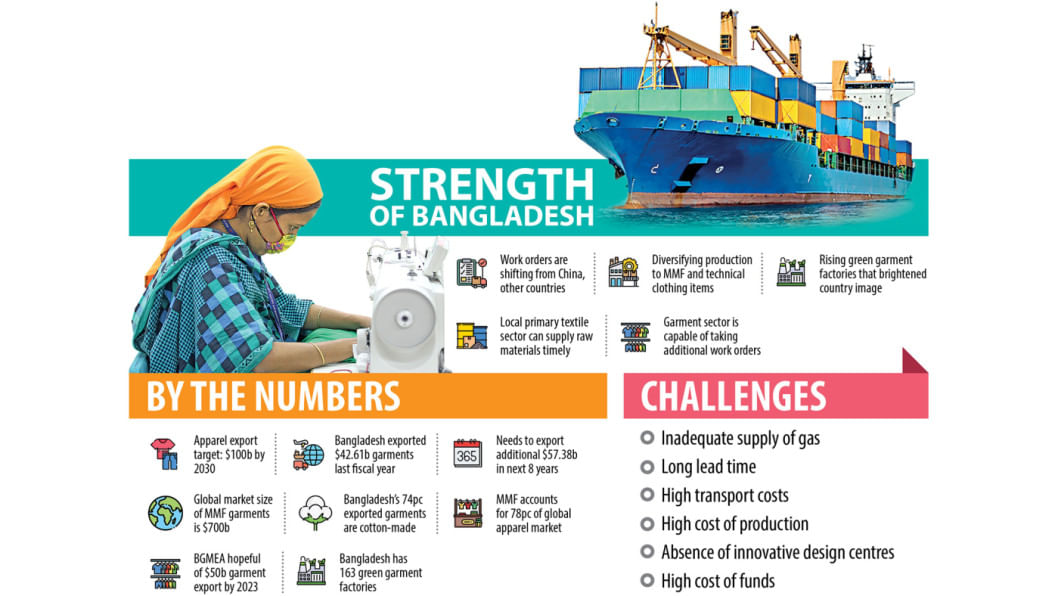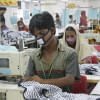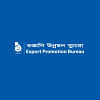BGMEA targets $100b export by 2030

The Bangladesh Garment Manufacturers and Exporters Association (BGMEA) yesterday set a $100-billion apparel shipment target by 2030, which is more than double the country fetched in the just-concluded financial year.
The platform is upbeat about hitting the goal as significant orders are shifting to Bangladesh from China and other countries and exporters are increasingly producing mid-range items, manufacturing more and more products from manmade fibre (MMF), and entering new markets.
The fresh target means suppliers will have to ship $7.17 billion additionally per year from the current level to reach the goal.
Bangladesh exported garment items worth $42.61 billion in the last fiscal year that ended on June 30, data from the Export Promotion Bureau showed.
"It is possible to achieve the target as we are diversifying the products and markets," said Faruque Hassan, president of the BGMEA, while unveiling the new logo and new vision of the platform at the Westin Hotel in Dhaka.
Bangladesh will mainly rely on three important products, including the shipment of mid-range garment items, MMF-made items and technical clothes like the uniforms used by healthcare professionals and professionals in other service sectors, said Hassan.
Exporters' presence in the $700-billion global MMF-made garment market is not that much as local producers are stronger in making apparel items from cotton fibre.
In the global fashion industry, 78 per cent of items are made from MMF and the rest are from cotton fibre. In the case of Bangladesh, cotton accounts for 74 per cent of items produced and only 26 per cent are MMF-based.
"So, we have a huge room to expand in the MMF and technical item segments as well as continuing our strength in the mid-range items," Hassan said.
Another strength of Bangladesh is the development of the local primary textile sector.
In the past, manufacturers used to face challenges in securing the supply of raw materials like fabrics and yarn on time. But the local primary textile sector has made huge strides in recent years, expanding its capacity significantly, thus cutting the long lead time.
The primary textile sector is also expanding its capacity to meet the demand for additional MMF, technical and other garment items.
The garment sector, however, had failed to achieve its $50 billion export target set for 2021, mainly because of externalities in 2016 and 2017 and the severe fallout of Covid-19 in 2020 and 2021, said Hassan.
"We expect that buyers will pay better prices for our diversified garment items."
Currently, the BGMEA is carrying out three studies to boost exports.
The studies are looking into how to innovate products, sell technical clothes and market products through digital platforms.
"The future of the garment business will depend on online sales," Hassan said.
According to the BGMEA chief, of the export-oriented garment items produced in Bangladesh by 2030, some 80 per cent would be manufactured in green garment factories as local manufacturers are turning to eco-friendly production in keeping with the demand from consumers more concerned about businesses' impacts on the environment.
Bangladesh is already a global champion in green garment factories and is home to 163 such factories, including 49 platinum-rated, the highest certification given by the US Green Building Council.
Although international retailers and brands are not paying higher prices for the green initiatives, they are placing more work orders with garment factories.
Speaking at the logo-unveiling event, Shirin Sharmin Chaudhury, speaker of parliament, suggested garment manufacturers not forget the issue of climate change and the importance of protecting waterbodies during production.
Abdus Salam Murshedy, a former president of the BGMEA, said many industries would be set up in the southwestern region of Bangladesh thanks to the opening of Padma Bridge.
The BGMEA's new logo represents nine concepts: people, inclusivity, transparency, infrastructure, innovation, circularity, global network, brand Bangladesh, and environment.
However, lifting the garment export to $100 billion won't be easy since Bangladesh will have to navigate challenges in the coming years.
The country is set to lose duty-free export benefits, which have turned Bangladesh into an apparel manufacturing hub, once it becomes a developing nation in 2026 after moving out of the group of the least-developed countries.
In an unpromising sign, the apparel industry could lose $5 billion in export earnings annually if the country can't retain the preferential trade benefit.
In a positive development, the European Union, the largest export destination of Bangladesh, has extended the duty-free export benefit to 2029. Australia has also assured Bangladesh of continuing the duty-free benefit after graduation.

 For all latest news, follow The Daily Star's Google News channel.
For all latest news, follow The Daily Star's Google News channel. 








Comments